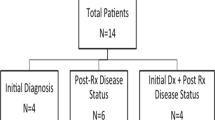Abstract
Patients with germline mutations in one of the SDH genes are at substantially increased risk of developing paragangliomas, pheochromocytomas (pheos), and other tumors (all combined referred to as SDH-related tumors). However, limited data exist on screening in SDH mutation carriers and no studies have evaluated whole-body MRI as a screening tool in asymptomatic patients. This was a single-center observational study. We evaluated the results of screening in 37 SDH carriers who underwent 45 whole-body MRIs and 47 biochemical tests. Screening included annual biochemical testing (catecholamines, metanephrines and chromogranin A) and biennial or annual rapid sequence whole-body MRI from the base of the skull to the pelvis beginning at age 10 years old. Six tumors (paragangliomas of the organ of Zuckerkandl, the aortocaval/vas deferens, of the carotid body times three, and a renal cell carcinoma) were diagnosed in five patients. In total, 13.5 % of all patients screened were diagnosed with SDH-related tumors. Whole-body MRI missed one tumor, while biochemical testing was normal in five patients with SDH-related tumors. The sensitivity of whole-body MRI was 87.5 % and the specificity was 94.7 %, while the sensitivity of biochemical testing was 37.5 % and the specificity was 94.9 %. Whole-body MRI had a higher sensitivity for SDH-related tumors than biochemical testing in patients undergoing screening due to their SDHB or SDHC mutation status. Whole-body MRI reduces radiation exposure compared to computed tomography scan and time compared to dedicated MRI of the head/neck, thorax, and abdomen/pelvis.

Similar content being viewed by others
References
DeLellis RA (2004) Pathology and genetics of tumours of endocrine organs. World Health Organization classification of tumours, vol 8. IARC Press, Lyon
Hensen EF, Bayley JP (2011) Recent advances in the genetics of SDH-related paraganglioma and pheochromocytoma. Fam Cancer 10(2):355–363. doi:10.1007/s10689-010-9402-1
Benn DE, Richardson AL, Marsh DJ, Robinson BG (2006) Genetic testing in pheochromocytoma- and paraganglioma-associated syndromes. Ann N Y Acad Sci 1073:104–111. doi:10.1196/annals.1353.011
Fishbein L, Nathanson KL (2012) Pheochromocytoma and paraganglioma: understanding the complexities of the genetic background. Cancer genetics 205(1–2):1–11. doi:10.1016/j.cancergen.2012.01.009
Amar L, Fassnacht M, Gimenez-Roqueplo AP, Januszewicz A, Prejbisz A, Timmers H, Plouin PF (2012) Long-term postoperative follow-up in patients with apparently benign pheochromocytoma and paraganglioma. Horm Metab Res 44(5):385–389. doi:10.1055/s-0031-1301339
Timmers HJ, Chen CC, Carrasquillo JA, Whatley M, Ling A, Eisenhofer G, King KS, Rao JU, Wesley RA, Adams KT, Pacak K (2012) Staging and functional characterization of pheochromocytoma and paraganglioma by 18F-fluorodeoxyglucose (18F-FDG) positron emission tomography. J Natl Cancer Inst 104(9):700–708. doi:10.1093/jnci/djs188
Kantorovich V, King KS, Pacak K (2010) SDH-related pheochromocytoma and paraganglioma. Best Prac Res Clin Endocrinol Metab 24(3):415–424. doi:10.1016/j.beem.2010.04.001
Parenti G, Zampetti B, Rapizzi E, Ercolino T, Giache V, Mannelli M (2012) Updated and new perspectives on diagnosis, prognosis, and therapy of malignant pheochromocytoma/paraganglioma. J oncol 2012:872713. doi:10.1155/2012/872713
Benn DE, Gimenez-Roqueplo AP, Reilly JR, Bertherat J, Burgess J, Byth K, Croxson M, Dahia PL, Elston M, Gimm O, Henley D, Herman P, Murday V, Niccoli-Sire P, Pasieka JL, Rohmer V, Tucker K, Jeunemaitre X, Marsh DJ, Plouin PF, Robinson BG (2006) Clinical presentation and penetrance of pheochromocytoma/paraganglioma syndromes. J Clin Endocrinol Metab 91(3):827–836. doi:10.1210/jc.2005-1862
Neumann HP, Pawlu C, Peczkowska M, Bausch B, McWhinney SR, Muresan M, Buchta M, Franke G, Klisch J, Bley TA, Hoegerle S, Boedeker CC, Opocher G, Schipper J, Januszewicz A, Eng C (2004) Distinct clinical features of paraganglioma syndromes associated with SDHB and SDHD gene mutations. JAMA J Am Med Assoc 292(8):943–951. doi:10.1001/jama.292.8.943
Timmers HJ, Pacak K, Huynh TT, Abu-Asab M, Tsokos M, Merino MJ, Baysal BE, Adams KT, Eisenhofer G (2008) Biochemically silent abdominal paragangliomas in patients with mutations in the succinate dehydrogenase subunit B gene. J Clin Endocrinol Metab 93(12):4826–4832. doi:10.1210/jc.2008-1093
Peck BW, Rich TA, Jimenez C, Kupferman ME (2011) A novel SDHB mutation associated with hereditary head and neck paraganglioma. The Laryngoscope 121(12):2572–2575. doi:10.1002/lary.22352
Schiffman JD (2011) No child left behind in SDHB testing for paragangliomas and pheochromocytomas. J Clin Oncol Off J Am Soc Clin Oncol 29(31):4070–4072. doi:10.1200/JCO.2011.37.8695
Heesterman BL, Bayley JP, Tops CM, Hes FJ, van Brussel BT, Corssmit EP, Hamming JF, van der Mey AG, Jansen JC (2012) High prevalence of occult paragangliomas in asymptomatic carriers of SDHD and SDHB gene mutations. EJHG, Eur J Human Genet. doi:10.1038/ejhg.2012.203
Gimenez-Roqueplo AP, Caumont-Prim A, Houzard C, Hignette C, Hernigou A, Halimi P, Niccoli P, Leboulleux S, Amar L, Borson-Chazot F, Cardot-Bauters C, Delemer B, Chabolle F, Coupier I, Libe R, Peitzsch M, Peyrard S, Tenenbaum F, Plouin PF, Chatellier G, Rohmer V (2012) Imaging work-up for screening of paraganglioma and pheochromocytoma in SDHx mutation carriers: a multicenter prospective study from the PGL.EVA investigators. J Clin Endocrinol Metab. doi:10.1210/jc.2012-2975
Villani A, Tabori U, Schiffman J, Shlien A, Beyene J, Druker H, Novokmet A, Finlay J, Malkin D (2011) Biochemical and imaging surveillance in germline TP53 mutation carriers with Li-Fraumeni syndrome: a prospective observational study. Lancet Oncol 12(6):559–567. doi:10.1016/S1470-2045(11)70119-X
Eisenhofer G, Pacak K, Huynh TT, Qin N, Bratslavsky G, Linehan WM, Mannelli M, Friberg P, Grebe SK, Timmers HJ, Bornstein SR, Lenders JW (2011) Catecholamine metabolomic and secretory phenotypes in phaeochromocytoma. Endocr Relat Cancer 18(1):97–111. doi:10.1677/ERC-10-0211
Timmers HJ, Chen CC, Carrasquillo JA, Whatley M, Ling A, Havekes B, Eisenhofer G, Martiniova L, Adams KT, Pacak K (2009) Comparison of 18F-fluoro-L-DOPA, 18F-fluoro-deoxyglucose, and 18F-fluorodopamine PET and 123I-MIBG scintigraphy in the localization of pheochromocytoma and paraganglioma. J Clin Endocrinol Metab 94(12):4757–4767. doi:10.1210/jc.2009-1248
Acknowledgments
We acknowledge the use of the Genetic Counseling Shared Resource supported by P30 CA042014 awarded to Huntsman Cancer Institute.
Conflict of interest
None to declare.
Author information
Authors and Affiliations
Corresponding author
Rights and permissions
About this article
Cite this article
Jasperson, K.W., Kohlmann, W., Gammon, A. et al. Role of rapid sequence whole-body MRI screening in SDH-associated hereditary paraganglioma families. Familial Cancer 13, 257–265 (2014). https://doi.org/10.1007/s10689-013-9639-6
Published:
Issue Date:
DOI: https://doi.org/10.1007/s10689-013-9639-6




